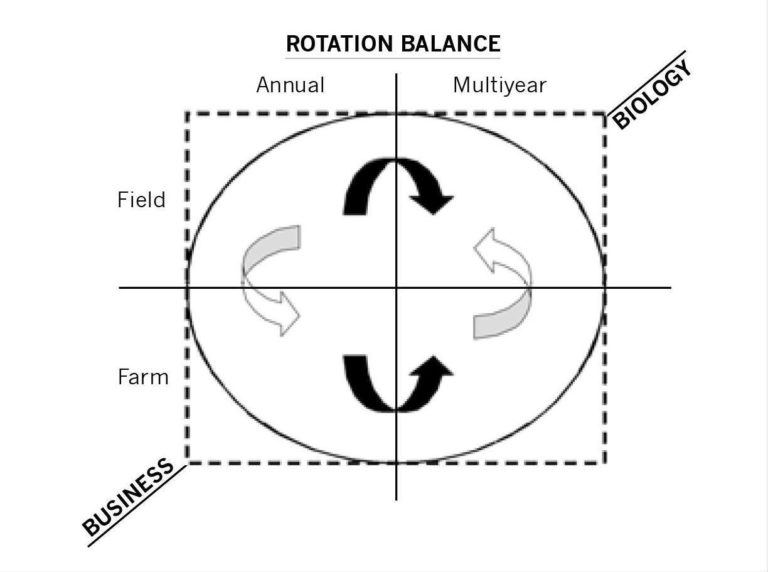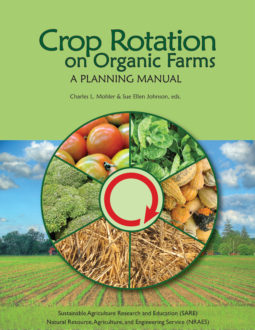Crop rotations require multidimensional thinking. Rotation management requires understanding both the whole farm and each individual field and balancing field and farm-scale decisions (figure 2.1). On successful farms, rotation planning is a rolling, responsive process. Expert farmers are continually balancing annual and multiyear (short- and long-term) decisions. Business decisions must be optimized for annual returns and cash flow. Expert growers indicate that in any given season, market opportunities and logistical needs may override biological concerns.

Experts manage multiple, interacting factors as they implement crop rotations. Organic farmers rely on rotations and long-term soil quality to deal with problems and ensure the productivity of fields more than they rely on fertilizers and pest control products. Their understanding of biological principles sets the boundaries of their management practices. Many expert farmers push and test the biological principles of crop rotation to the limit to meet management and business demands.
Expert farmers plan and implement rotations on an annual, seasonal, and last-minute opportunistic basis. Their annual plans are based on clear priorities. Each year the paramount challenge is to grow adequate quantities of profitable crops to keep the farm viable. At the same time farmers are deciding the rotational sequence on each field, they must consider how to rotate equipment and labor efficiently across the entire farm operation. Crop cultural and harvest characteristics—including the logistics of labor-intensive weeding or multiple harvests; vehicle access; and keeping crops like pumpkins or flowers secure from vandals, thieves, and wildlife—have to be managed across farm and field. Meanwhile, meeting market demands and maintaining cash flow are farm business issues that must be integrated with field decisions. Inevitably, expert farmers also adapt to the weather conditions of specific years, often by changing their crop mix and, consequently, their rotations.

Most farms have a few key cash crops that generate significant income. Year by year, expert farmers focus on planting their key crops in the most suitable fields for those crops without compromising the soil health and long-term productivity of those fields. Generally, these crop-to-field matches are first made based on market and logistical considerations (see sidebar 2.5). Then expert farmers review whether there are biological reasons to go in a different direction. They cross-check “what not to do” (see appendix 2) biologically with both their experience and their knowledge. Farmers take special care to manage the production and soil capital of their best fields. Relying on their knowledge of their fields and the crops they grow, and some general principles (for example, avoid planting related crops in the same field year after year), expert farmers determine the crop for each field each year.
In any given year, field history, along with the weather, determine the suitability of a field for a particular crop. On many farms in the northeast US, any one field (or bed) is usually not interchangeable with all the others on the farm. Fields, even beds, have unique attributes because of soil parent material and landscape position. Even if soils are similar, microclimates, access to irrigation, and distance to roads or packing facilities cause some fields to be better suited for certain crops. Some fields are simply more productive; others have particular histories or problems that preclude certain crops or rotations.
Expert farmers understand that each field’s biological management is central to the long-term success of the overall farm business. They monitor and manage crop rotation to limit negative impacts on any one field. Biological guidelines come into decisions at every convenient opportunity (for example, a field that was too wet for a planned early spring crop is now open for a cover crop). Biological guidelines also enter into decisions when a problem becomes evident and must be addressed (for example, a soilborne disease such as Phytophthora).
Opportunistic Decisions: Business Overrides Biology
Unexpected opportunities and circumstances often confront farmers. Expert farmers go through the following steps as they manage these situations:
- Recognition of a market opportunity or logistical contingency (such as a change in weather, equipment, or labor availability).
- Feasibility assessment to determine whether the market can be met successfully. Considering the available land, labor, equipment, and irrigation, will the change increase the overall profitability of the farm operation? What is the cascade effect across the farm?
- Biological cross-check to determine the field or variety. For example, a more disease-resistant variety may be selected if taking advantage of the economic opportunity means that the rotation time between susceptible crops would be decreased.
Biological “rules” may be stretched to meet the market, but they are not repeatedly ignored on the same fields.
Frequently, expert farmers design crop sequences to set up for future key crops, in addition to meeting the current season’s production needs. For example, for a successful early seeding of a small-seeded crop like carrot the rotation sequence must be planned so that the residue of the previous crop will be fully broken down—providing the proper seedbed for the next season’s crop. Other sequences may be designed so that substantial spring growth of an overwintering cover crop precedes a heavy-feeding cash crop. For example, a field could be planted with a summer-harvested crop such as sweet corn in the current year, so that a hairy vetch cover crop has time to establish in the fall and supply nitrogen for a heavy-feeding cucurbit the following spring. High-value crops that are difficult to grow are often pivotal in determining a rotation, because they are the most critical in terms of both the business and the biology of the farm.
Of course, plans don’t always go as expected. Market opportunities or weather may dictate a change in a rotation (sidebar 2.5). Seed may not be available or viable. A field may have weed problems or a pest outbreak that is best addressed by rotation. The experts build flexibility and responsiveness into their annual plans.
Expert farmers often need to make decisions for individual fields on the fly, based on their experience and knowledge of each field and the overall farm. They know what can go wrong. They know the limits of their systems. As business managers, they are continually reviewing the farm and its operational capabilities. Many farmers rely on their mental categorization of crops and fields (described in sidebar 2.9) which makes the quick substitution of crops easier. A tool for crop categorization and allocation of crops to fields is introduced in chapter 5.
Expert farmers balance the farm business, farm management, and field biology. Since they manage their systems intuitively, they do not always distinguish farm planning from crop rotation planning. For example, choosing the crop mix is a market-driven business decision, which is coupled with the allocation of crops to fields, which is a biological and logistical decision.
